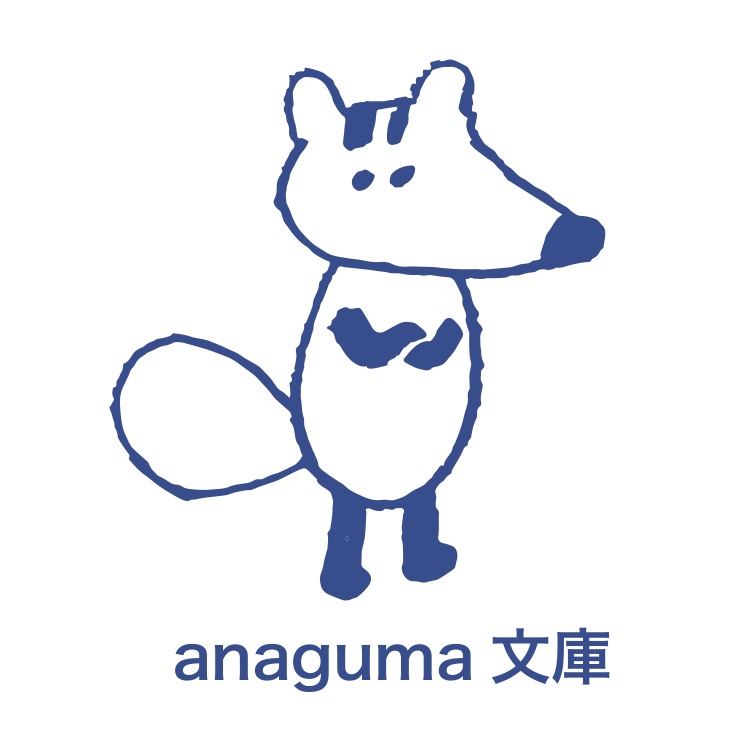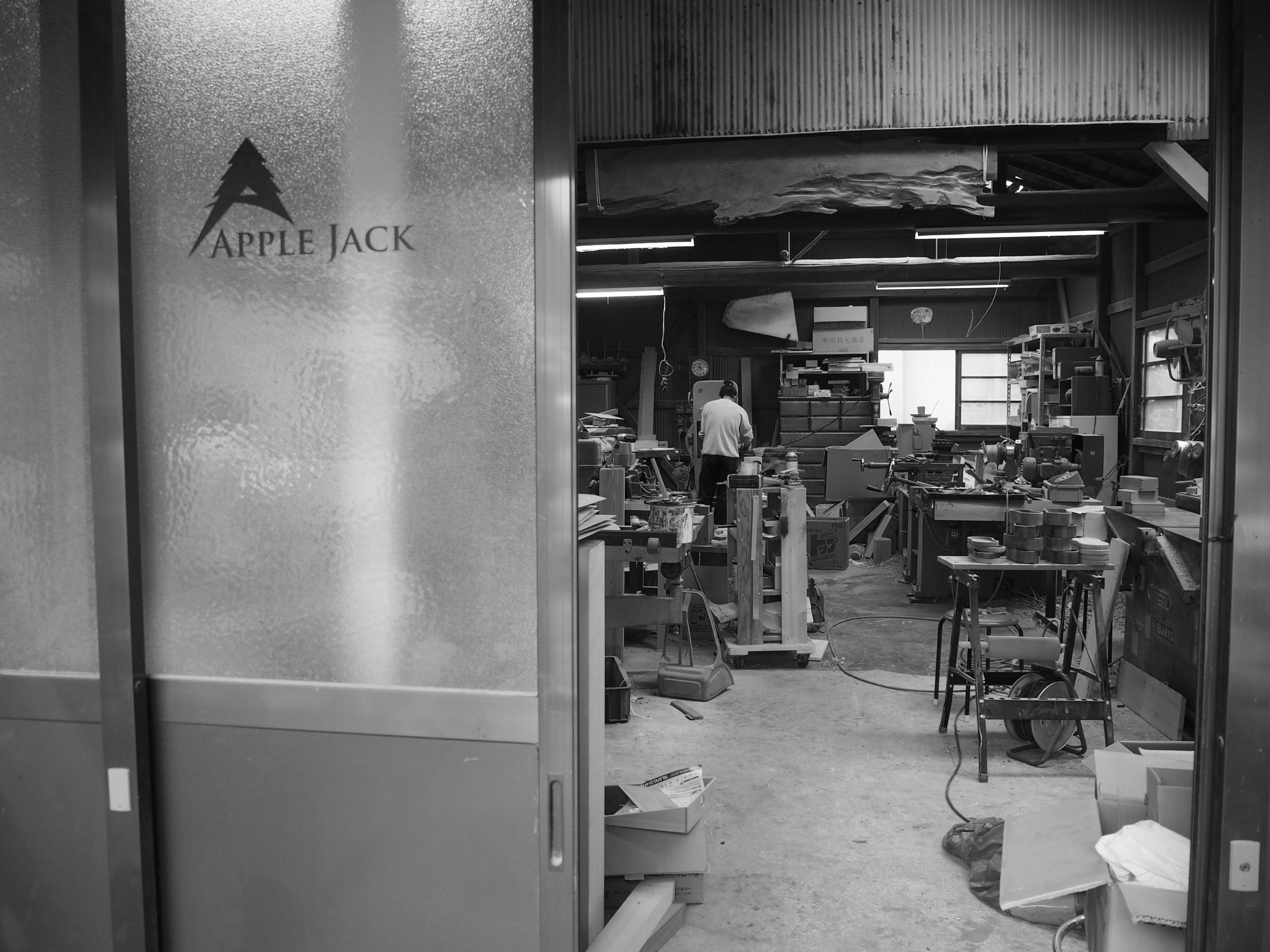(Please scroll down for the English version.)
トーク・オン・ウッド: アップルジャック
「すべてのものには季節があり、(ターン、ターン、ターン)
すべてに時機がある。(ターン、ターン、ターン)
すべての目的にはときがあり、ときには意味がある。」
-「ターン!ターン!ターン!」ピート・シーガー
パイロットの夢を見て、小林さんは航空自衛隊に入隊したが、結局航空機の整備長として九年間従事した。実家の川上村に帰った時、ちょうど川上村の木工センターが人を募集していた。小林さんは木工について何も知らなかったが、自衛隊で機械をよく使っていたので、その経験が木工センターで役に立つことになる。小林さんは機械を使いながら、木を触りながら、木工の経験を積んで、二十五年間木工センターで勤務した。
7年前に小林さんは自分の工房を始めた。自分の工房を何と呼ぶかを考えた時に、小林さんは自衛隊での経験を思い出した。航空自衛隊では、3段階の防空状態が「アップルジャック(赤、防空警報)」、「レモンジュース(黄、警戒警報)」、「スノーマン(白、警報解除)」と設定されている。小林さんは「いつも自作状態でおらなあかんと思って、『アップル・ジャック』を付けたんやわ」と。最初から注文が来なくて、オルゴールの流す「カノン」によく癒された。
現在、そのオルゴールは木の音響箱の上に乗せられて、ショップ中に音楽を流す。ショップはお客様にもらったアート作品や航空自衛隊のモデルプレーンで飾っている。それらの下に工房アップル・ジャックの品揃えが静かに光っている。吉野ヒノキの器、黒檀の果物ナイフ、スネークウッドの箸、桜の木の箱などの商品は「木」というものの多様性を見せる。しかし、何よりも多いのは吉野杉の商品である。
工房の方で、キャッチャーのサインを読み取るピッチャーのような目つきで、小林さんはろくろに付いている吉野杉の茶碗を深く見つめる。ろくろを稼働して、回転している茶碗の中を刃物で調整する。この繰り返しで、小林さんは茶碗を形作り、他の工房より薄くて軽いの茶碗ができる。200グラムの茶碗を「超軽量」とした世界で、工房アップル・ジャックの40グラムの茶碗が「超超軽量」になる。展示会のお客様はこの茶碗を持ち上げたら、茶碗の軽さに騙されて、手からすっぽ抜けてしまうことがある。
杉は他の木より柔らかいため、木工に向いていないと思われる。しかし、あえて木工で使われたら、細かくて綺麗な年輪の色彩が生き生きする。他の木工家はこの木材を挑戦しても、工房アップル・ジャックほど薄く伐らない。それは小林さんにとってやりがいになる。工房アップル・ジャックは縁の角度を小さく調整するだけで、コースターや器を味のある上品なものにする。その特技がサンクゼール、奈良ホテル、日本全国の飲食店や商店に認められて、注文がきているらしい。しかし、工房が繁盛していても、小林さんは「工房アップル・ジャック」の名前を変えずに、緊張状態のしっかりした姿勢を保ちながら、商品を次々に作る。
吉野杉の繊細な年輪を数えてみたら、そのコップやお盆や茶碗の過去をなんだか感じ取れる。その木がいつ、どこ、誰に植えられて、育てられたかを考えさせる。工房アップル・ジャックの近くに、小林さんの先祖が植えた吉野杉がある。小林さんはその山の次の世代、と次の次の世代について話してくださった。
「その時代に合わせた植え方だったらええちゃう。杉檜の木は川上村の宝物だから、残さなあかんけど、まあ、一部は広葉樹でええと思う。広葉樹は山の上の方がええらしい。養分が上から流れてくるから、杉やヒノキに栄養が行き渡る。昔は上を残していた、松林とかで。土倉庄三郎さんの考えで『上を残す』と。」
Talk On Wood: Apple Jack
“To everything (Turn, turn, turn),
There is a season (Turn, turn, turn),
A time for every purpose under heaven.”
-“Turn! Turn! Turn!” Pete Seeger
With dreams of being a pilot, Mr. Kobayashi entered the Japan Air Self-Defense Force, but ended up working in the aircraft maintenance department for nine years. When he came back to his home in Kawakami Village, the Village Woodworking Center was accepting applications for work. Mr. Kobayashi didn’t know anything about woodworking, but since he had worked with machines in the Self-Defense Force, that experience would come in handy at the Village Woodworking Center. He learned through experience using the machines and handling the wood, and worked for 25 years at the Village Woodworking Center.
Seven years ago, Mr. Kobayashi started his own studio. When he was thinking about what to call his studio, he recalled his days in the Self-Defense Force. In the Japan Air Self-Defense Force, there are three levels of threat: “Apple Jack (red, air defense alarm)”, “Lemon Juice (yellow, warning alarm)”, and “Snowman (white, alarm cancelled)”. Mr. Kobayashi said, “I felt that I should always take care of my self, so I named my studio ‘Apple Jack’.” Orders didn’t come at first, but he was comforted by the melody of “Canon” played by a music box.
Today, that music box sits on top of wooden acoustic box and fills the shop with music. The shop is decorated with artwork from customers and models of Japan Air Self-Defense Force planes. Below those, the products of Apple Jack quietly shine. Yoshino cypress dishes, ebony fruit knives, snakewood chopsticks, and cherry wood lunch boxes show the diversity of “wood”. However, there are more products made from Yoshino cedar than anything else.
In this studio, with eyes like a pitcher reading signs from a catcher, Mr. Kobayashi looks deep into the Yoshino cedar bowl attached to the wood lathe. He powers on the lathe, and adjusts the inside of the spinning bowl with a blade. He repeats this to gradually shape and make a bowl that is thinner and lighter than others. In a world where a 200 gram bowl is considered to be “extremely light”, Apple Jack’s 40 gram is “extremely, extremely light”. Customers at exhibitions and shows often pick up the bowl, and tricked by its light weight, end up nearly throwing it up in the air.
Yoshino cedar is thought to be difficult for woodworking since it is softer than most other woods. However, when it is used in woodworking, the colors of its thin, beautiful grain come alive. Even if other craftsmen take on the challenge of using Yoshino cedar, they probably can’t cut it as thin as Apple Jack. That’s part of what motivates Mr. Kobayashi. Apple Jack will adjust the angle of an edge to change a coaster or a dish into something tasteful and elegant. That ability was recognized by San Cousier, Nara Hotel, and restaurants and shops all across Japan, with plenty of orders coming in. However, no matter how successful the shop is, Mr. Kobayashi is keeping the name “Apple Jack”, staying tense and ready, and creating one product after another.
When I try counting the fine rings of Yoshino cedar, I can get a feel for the past of the cups, trays, and bowls. It makes me think about when, where, and by who the tree was planted and raised. There are some trees planted by Mr. Kobayashi’s ancestors near the Apple Jack studio. Mr. Kobayashi talked about the next generation of that mountain, as well as the one after that.
“I think they should plant the trees in way that’s appropriate for that generation. Cedar and cypress trees are the treasures of Kawakami, so of course we need to keep them, but well, I think it’d be a good idea to plant some broadleaf trees. They say the top of the mountain should be broadleaf trees. The nutrients flow from the top down the mountain to the cedar and cypress. A long time ago, they used to keep the top of mountain for pine forests. It was Dogura Shozaburo’s way of thinking to ‘leave the top’ they say.”







